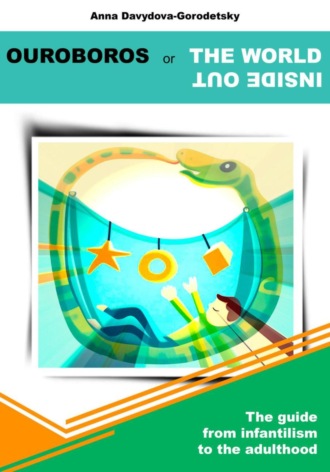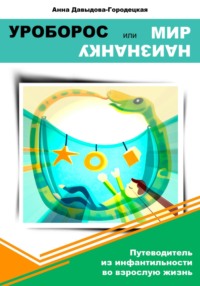
Полная версия
Ouroboros or the world inside out
Similarly, stability for a child and stability for an adult are different. Childlike stability, which is the absence of change, is often detrimental for an adult, who must develop. The lack of a stable financial position in childhood will lead an adult to seek money based on a childish idea of what it is and how to spend it.
This means that the illusory reference pattern is strongly detached from the reality in which a person lives. It corresponds to the reality of the age and conditions when it was formed. Additionally, it contains details that do not fit well together or contradict each other, such as "career success" and «stability». It is a dream-Frankenstein, made up of unmet needs from the past, plots of movies and books from youth, and dreams from different time periods. These disparate fragments are sewn together by the illusion of feasibility and dangled in front of the ouroboric personality like a carrot in front of a donkey.
In adulthood, this reference pattern is either unachievable (such as unconditional love) or, if achievable, dysfunctional and ridiculous. Upon achieving it, one realizes that the embodied dream does not bring satisfaction. For example, if a woman grew up in a family with an aggressive man, she felt defenseless and now seeks the kind of protection a child needs. She will find such protection and end up with an overwhelming and controlling husband. Later, she will complain to a shrink or friends that he "deprives her of freedom" and "does not let her breathe," making it «unbearable». Nevertheless, the ouroboric psyche will continue to strive for this reference pattern, ignoring reality.
I once overheard a conversation between two intelligent-looking women. One said to the other, “I have to go get a manicure, because I've been walking like a scourge[2] for a week. This phrase encapsulates a lot – from the sense of inferiority due to the lack of a manicure to the use of slang as a demonstration of vulnerability (exporting vulnerability) and self-criticism for not meeting her own standards. It becomes clear that this woman has a detail called «Beauty» in her reference pattern, which was incorporated in childhood and includes an obligatory component of external grooming. Any inconsistency with this plunges her into vulnerability and self-criticism, manifesting as calling herself unpleasant names. Such a woman might tolerate being rude, incompetent, or hysterical, but she cannot tolerate not having a manicure.
As mentioned earlier, the core of the reference pattern is based on unmet childhood needs, but it is replenished, modernized, and adapted throughout life. Adaptation is generally understood positively as adjusting to current needs. However, in ouroboric reality, adaptation means maintaining the impracticability and dysfunctionality of the reference pattern by adding elements that cannot be realized in the person's current life conditions. For example, my friend, after having a daughter with autism, reformatted her reference pattern by adding a detail called "Healthy Child," which is obviously unattainable at the moment. Consequently, her internal inferiority and external vulnerability grew, and everything that did not match the new reference pattern – essentially her entire real life – was devalued.
If we compare a person's life path to a bumpy road with relatively smooth places and deep holes, then in the world of Ouroboros, this road is flooded with water, hiding the roughness from the person walking on it. This water represents illusion. Where there are holes in the road, indicating a lack of something, there is a lot of water-illusions. A person walking along this metaphorical road, flooded with illusions, does not see its roughness and can stumble on a bump or fall into a pit. A person who has passed the ouroboric stage and matured into an adult personality is devoid of illusions. They live in the real world and clearly see the road they are walking on: they see the bump that must be crossed and the pit that must be bypassed. Such a person can minimize troubles from the unevenness of the «road» and plan their life because they know where they are going and how to make the journey from point A to point B as comfortable and safe as possible.
Full-value
I have already written that true authenticity, or full-value, is characteristic only of a psychologically mature person and is not available to an infantile one. A mature person knows exactly who they are and can rely on this knowledge in their daily life; they have no need to compare themselves with anyone, or if they do, it does not disrupt their inner equilibrium. The ouroboric personality, however, can only understand who they are by comparing themselves to others and determining if they are better or worse, or by comparing themselves to their own reference pattern and finding that they are always worse.
In the structure of the infantile personality, "ouroboric full-value" is the simplest and most linear concept. As Oscar Wilde said, "I'm a man of simple tastes. I'm always satisfied with the best". To achieve ouroboric full-value, one must connect with their reference pattern and realize all the details that comprise it. This seems straightforward, but the challenge lies in how to actually do it. Inferiority is like the ocean – vast and deep. Let's try to make sense of it.
Inferiority
While studying the structure of my personality, I had recurring dreams where I was walking barefoot on a dirty floor (in the common hall of my apartment building, in a public toilet) or on the dirt of the street (on my way from work to home). Sometimes, I would suddenly notice I was shoeless, or I was forced to take off my shoes by a public toilet worker who insisted they were clean and I would dirty them, despite the floor being covered in wet mud. In the dream, nothing prevented me from washing my feet and putting my shoes back on, but for some reason, I didn't do it. Reflecting on these dreams, I realized they symbolized «inferiority» (ouroboric «unhappiness» or vulnerability), a humiliated and helpless state I periodically sink into when comparing my life to my reference pattern or to others.
I believe that this sense of inferiority, combined with the illusion that someday something will happen – a chance encounter or lucky coincidence – that will end this inferiority and vulnerability and replace it with full-value and superiority, is what drives the ouroboric wheel. Inferiority is a crucial point in this system. Without immersing oneself in it, the illusion becomes unnecessary. Escaping this state is both easy and difficult.
It is easy because no one but ourselves forces us into vulnerability, and if there is coercion, we can resist it by simply refusing to humiliate ourselves. It is difficult because our entire previous life has been spent in this state, and we have no experience of life outside of inner inferiority.
Our experience of life follows this paradigm: comparing oneself with the reference pattern → inconsistency → «inferiority» → auto-aggression for inferiority → waiting for an «event» that will lead to a connection with the reference pattern to achieve «full-value». This means I carry the reference pattern of myself and my life, I do not match this pattern, I reject myself, and I am in a state of inferiority. While in this state, I believe in the illusion that it will end when the desired «event» happens. Simultaneously, everything else not included in this cycle is devalued. The «event» does not happen, the feeling of inner inferiority persists, and the ideal remains unattainable. It is necessary to break this vicious circle. To stop believing in the "event," to give up the reference pattern of oneself, to control the manifestations of vulnerability, and to get out of this state by an effort of will. And wait for the state outside of this rut to become a routine.
Конец ознакомительного фрагмента.
Текст предоставлен ООО «Литрес».
Прочитайте эту книгу целиком, купив полную легальную версию на Литрес.
Безопасно оплатить книгу можно банковской картой Visa, MasterCard, Maestro, со счета мобильного телефона, с платежного терминала, в салоне МТС или Связной, через PayPal, WebMoney, Яндекс.Деньги, QIWI Кошелек, бонусными картами или другим удобным Вам способом.
Примечания
1
Ouroboros (lit. – «tail-eater» from ancient Greek οὐροβόρος from οὐρά «tail» + βορά "food, meal") is a serpent or lizard coiled in a ring, biting itself by the tail. It is one of the oldest symbols known to mankind, the exact origin of which – the historical period and specific culture – is impossible to establish.
2
Scourge – jarg. a downcast, drunken person.




